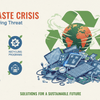The E-Waste Problem: Key Information and Actionable Tips

Introduction
E-waste is a problem growing in the world, affecting every home, office, and city. With technological advancement, these gadgets have become a part of life. People are purchasing new laptops, mobiles, and smartwatches more frequently. They easily dispose of old devices, which contributes to an enormous amount of waste generated. E-waste poses a threat to the environment, soil pollution, and human health due to the presence of metals and chemicals, which need proper handling. This blog explains, with simple sentences, the important facts about the E-waste problem. It further elaborates on practical tips in daily life to minimize waste and protect the environment.
Understanding the E-Waste Problem
The E-waste problem is increasing each year. A new phone or laptop is bought, and the old ones are just put aside, unused. Many of these gadgets go directly into dustbins or landfills. This is risky because within an electric gadget, there is a number of toxic metals present, such as lead, mercury, and cadmium. These elements contaminate soil and water. When burned, E-waste emits greenhouse gases. New mobile phones come out every year, so people upgrade to newer versions. Laptops and smartwatches also run the cycle of getting outdated quickly. This problem becomes even larger with the growing digital lifestyles. A little awareness and responsible disposal can reduce the harm caused.
Why Laptops, Mobiles, and Smartwatches Create So Much E-Waste
Laptops, mobiles, and smartwatches are changed far more frequently than any other older version of electronics. Newer models arrive every year, and most users tend to purchase the latest version, even when their older devices are still operational. For no reason at all, this creates a lot of E-waste. Mobile phones have a short life for batteries after 2–3 years. The smartwatches start lagging and do not get updates. Laptops also become slow because of their heavy applications. Manufacturers stop supporting them too. Due to these reasons, people start discarding them way earlier. Repairs are costly; hence, buying new devices seems easier. This cycle adds millions of devices to global waste.
Environmental Impact of E-Waste
The E-waste problem is hazardous because it mediates between air, soil, and water. When electronics break down, toxic elements are released. These toxins enter the ground and contaminate plants and water sources. Burning E-waste produces harmful smoke that affects breathing. Many countries send E-waste to developing regions where workers sort wastes without safety tools. It exposes them to poisonous chemicals. Oceans also suffer because dumped electronics reach water bodies. Fish and marine animals get harmed due to microplastic and heavy metals. Managing E-waste rightly is important for a clean and safe environment.
How E-Waste Affects Human Health
E-waste possesses serious health impacts. Individuals who handle E-waste without protection inhale noxious fumes, which can be responsible for lung problems, headaches, and allergies. Hazardous metals in electronic equipment have influences on both the brain and nervous system. Exposure to lead may retard brain development in children. Mercury impairs the kidney and immune system. Batteries from phones and watches are usually recycled, but they leak chemicals. These chemicals then enter into groundwater and affect drinking water. Communities living in the vicinity of a landfill site have a larger probability of cancer and respiratory diseases. The E-waste problem is not only an environmental issue but also a public-health threat.
Actionable Tips to Reduce E-Waste from Laptops
Simple ways exist to reduce E-waste created by laptops: Users can upgrade RAM or storage instead of buying new models. Regular cleaning and updating of the operating system extend the life of a laptop. Employ protective cases to reduce breakages. If the laptop slows down, it's usually easy to reinstall the OS. Many companies run trade-in programs for old laptops. Donation of functional laptops to schools and non-government organizations creates no waste. Repairs by shops can also fix many issues at low costs. Always check energy labels and buy durable laptops. Responsible use and maintenance reduce the growth in electronic wastes.
Actionable Tips to Reduce E-Waste from Mobile Phones
Mobile phones are the major contributor of E-waste. Waste can be reduced by simple actions. The screen protector and covers save these gadgets from damage. Instead of buying a new phone, one can replace the battery. There is no need to buy a new model every year. Deleting unwanted files frees up space in them and increases the speed. Exchange old phones through brand programs. Sell old phones to certified refurbishers. Donate working phones to charity organizations. Do not throw them in the trash. Store the phones safely until they are sent for recycling. These little acts would reduce the problem of E-waste to a great extent.
Actionable Tips to Reduce E-Waste from Smartwatches
Smartwatches are also part of the E-waste contribution. Users are supposed to choose watches that have replaceable straps, with long-term firmware support. Keeping the software updated will extend the device life. Protect the battery by not overcharging it. When the smartwatch stops working, first see if it can be repaired. Smartwatches can also be traded in and recycled. Make sure to buy devices from brands that use sustainable manufacturing methods. Buying only what is needed reduces electronic waste. If the watch will still be functional, give it to another family member or donate it. The responsible use of smartwatches reduces electronic waste and protects the environment.
Importance of Recycling E-Waste Properly
Recycling is one of the most efficient ways of managing E-waste. Several materials inside electronic gadgets are reusable. Metals like gold, copper, and silver have value. Recycling cuts down on mining new ones. Certified recycling centers take safe methods to segregate parts. They do not let harmful chemicals out into the environment. In a number of countries, shops and malls provide E-waste drop-off points. Users should find out if recyclers are government-accredited. Proper recycling will result in a reduction of pollution and facilitate a circular economy. This also provides jobs for waste-management workers. Recycling should be a regular habit at every household.
Why Consumer Awareness Matters
The biggest role of consumers is in reduction. People should think before buying new electronics. They should maintain the devices properly in order to make the devices last longer. It is very important to choose brands with strong policies in regard to repair and recycling. Reading the labels on products and energy ratings assists in making better choices. Sharing information with friends and family spreads the circle of awareness. Small daily choices build into one large impact. When consumers become responsible, companies also tend to become more accountable. Society can hence control the E-waste problem together and create a sustainable future.
Conclusion
The E-waste problem is a growing global issue. Laptops, mobiles, and smartwatches contribute a lot to this challenge. Simple actions of repair, recycling, donation, and responsible buying could reduce waste. E-waste damages the environment, and human health is in danger, so proper disposal is a must. People should be well aware of how to manage electronics at the end of their life cycle. To solve the problem, the approach has to come from governments, companies, and individuals together. Every small step taken helps protect the planet. Reduction of E-waste is not hard if simple and consistent habits are followed.
FAQs
Q.1. What is E-waste?
E-waste refers to old or broken electronic items such as mobiles, laptops, and smartwatches.
Q.2. Why is E-waste harmful?
It contains toxic chemicals, which pollute air, water, and soil.
Q.3. How can I reduce e-waste at home?
Fix them, donate them, and recycle them responsibly.
Q.4. Can mobiles and laptops be recycled?
Yes, most parts can be recycled safely through certified centers.
Q.5. Which is the best habit for preventing E-waste?
Buy only when needed and care for devices to make them last longer.





